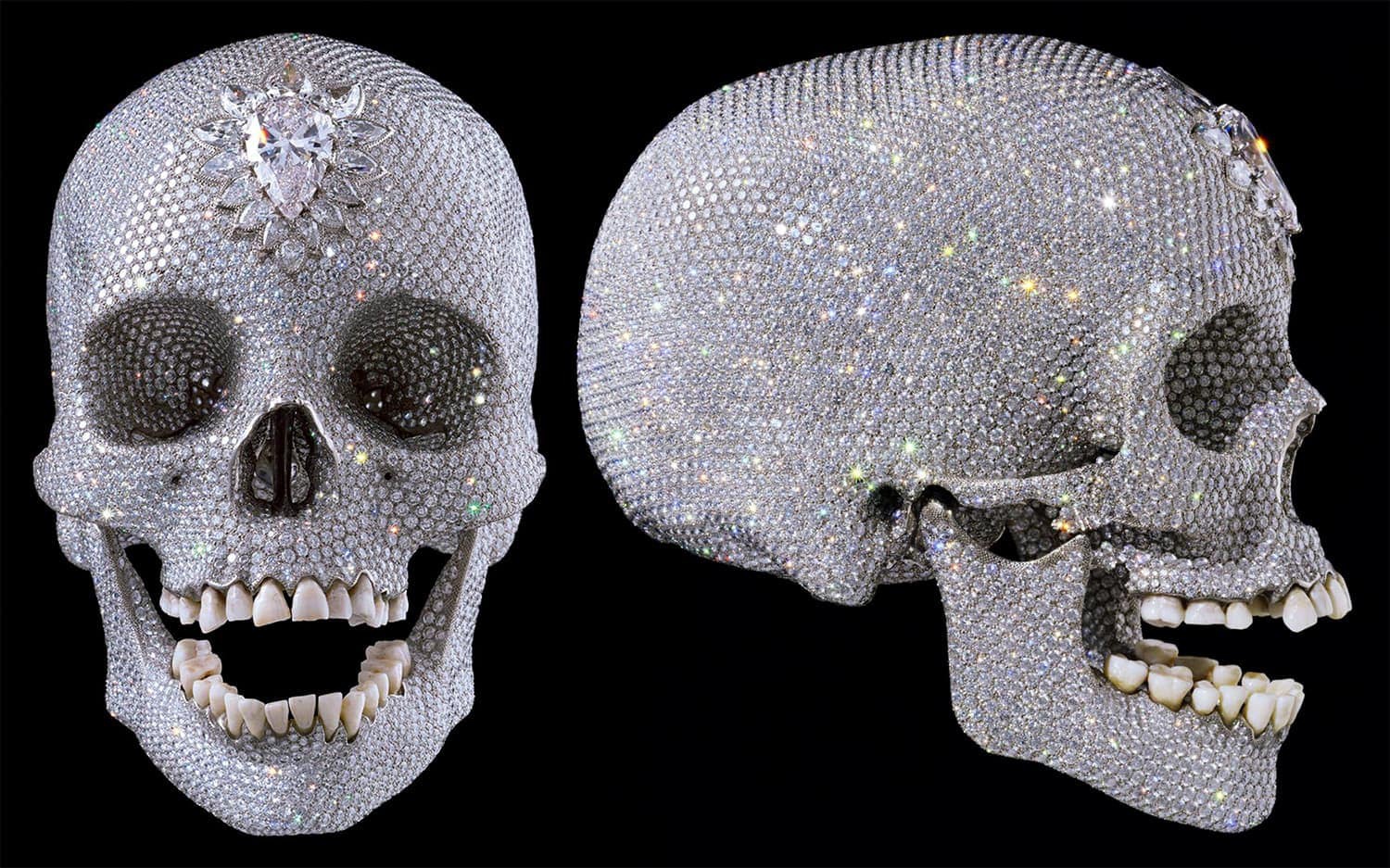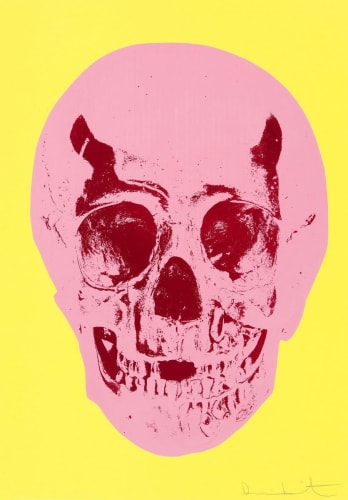Damien Hirst, one of the most influential igures in contemporary art, has long been fascinated with the themes of death and mortality. His work often challenges the viewer to confront the inevitability of death, using striking and sometimes shocking imagery to explore the human condition. Hirst's career, which began in the late 1980s, is marked by a relentless inquiry into life’s transience and the intersection of art, science, and philosophy. From his iconic installations involving preserved animals to his elaborate diamond-encrusted skulls, Hirst continually pushes the boundaries of artistic expression. His exploration of mortality is not just an obsession with the macabre but a profound meditation on the nature of existence and the enduring legacy of art. Through his work, Hirst invites us to reflect on the fleeting nature of life and the ways in which we seek to immortalize ourselves and our experiences.

In 2007, Damien Hirst unveiled one of the most extravagant and thought-provoking artworks of his career at the White Cube gallery in London. Titled "For the Love of God," the piece is reputed to be the most expensive contemporary artwork ever made, financed by an investment of $28 million from Hirst's own funds. The work consists of a platinum cast of a human skull from the mid-1800s, encrusted with 8,601 of the world's finest diamonds, including a large pink diamond on the forehead. The skull retains its original human teeth, adding a macabre authenticity to the dazzling spectacle. The title reportedly comes from a question posed by Hirst’s mother, "For the love of God, what are you going to do next?"
The creation of "For the Love of God" involved a meticulous process of acquiring diamonds from Bond Street gem dealer Bentley & Skinner, which significantly impacted the global price of diamonds during the months of acquisition. Inspired by the Aztec turquoise mosaic skulls at the British Museum, Hirst initially hesitated due to the prohibitive costs. However, he eventually embraced the idea that the ludicrous expense could serve as the work’s rationale. Hirst's intention was to laugh in the face of death, using the skull as a symbol to challenge and reflect on mortality. This defiant stance against death aligns with his belief in the immortality conferred through art collecting, suggesting that owning and displaying art offers a form of legacy and permanence.
Beyond its sensationalism, "For the Love of God" invites contemplation on the relationship between art and value. While Hirst posits that art collecting can bestow a certain kind of immortality, the piece also exemplifies Karl Marx’s notion of capital perpetually transforming commodities. The artwork’s transformation of diamonds—objects of pure exchange value—into a provocative art piece encapsulates the commodification and circulation of capital. Furthermore, the use of a real human skull and the labor-intensive diamond mining process underscore the exploitation of human life and labor in creating luxury items. Hirst’s reflection on the deadly potential of this opulent object echoes the complex interplay between mortality, material wealth, and artistic legacy.

Damien Hirst's 2010 series "Till Death Do Us Part" presents a striking collection of brightly saturated screen prints, each featuring a front-facing human skull. The series, influenced by Pop artist Andy Warhol, consists of silkscreen images taken from photographs of a skull, flattened and depicted in vivid, block colors. This repetitive use of a single image across the series reflects Warhol's fascination with mass reproduction and the democratization of high art, transforming a morbid subject into a visually captivating motif.
Hirst’s approach to the "Till Death Do Us Part" series pays homage to Warhol's exploration of death and repetition. By repeatedly depicting the skull, Hirst desensitizes viewers to the symbol of mortality while simultaneously amplifying its significance. This paradoxical treatment aligns with the art historical genre of vanitas still life painting, where the skull serves as a reminder of human mortality and the fragility of life. Hirst’s use of bold, non-naturalistic colors creates a jarring effect, contrasting the morbid subject matter with vibrant hues, thereby challenging the viewer's perception and evoking a deeper reflection on life and death.
The simplistic yet powerful imagery in "Till Death Do Us Part" engages universally resonant themes. The stark contrast between the skull's fine detail and the dark backdrop emphasizes the tension between the transient nature of life and the permanence of death. Hirst's manipulation of color and form invites viewers to confront the inevitability of mortality, while also celebrating the enduring impact of art. By reinterpreting the skull through a contemporary lens, Hirst continues to explore the intersection of truth, beauty, and the human condition, inviting audiences to reconsider their own relationship with death.

In his 2009 series "The Dead," Damien Hirst further delves into the theme of mortality, creating thirty-one unique prints, each depicting a large, floating skull rendered in various combinations of bold and vibrant colors. This series highlights Hirst’s fascination with death and his stylistic affinity with Pop Art, particularly the influence of Andy Warhol. Warhol’s practice of blurring the boundaries between high and low culture is echoed in Hirst’s transformation of the skull—a symbol of death—into a work of fine art, challenging conventional notions of what constitutes art.
Each print in "The Dead" series features a different color palette, ensuring that no two prints are identical. This variation underscores the uniqueness of each human life, even as the skull remains a universal symbol of mortality. The use of bright, eye-catching colors serves to juxtapose the somber theme of death with a sense of vibrancy and life, encouraging viewers to embrace the inevitability of death rather than fear it. Hirst's intention is to use the imagery of the skull not as a source of dread, but as a means to invigorate and inspire reflection on the transient nature of existence.
Hirst's long-standing interest in life and death is evident throughout his career, from his early visits to the anatomy department of Leeds Medical School to his iconic installations such as "The Physical Impossibility of Death in the Mind of Someone Living" (1991). In "The Dead" series, Hirst continues to explore these themes, using the skull as a memento mori—a reminder of mortality. The artist’s use of color and form transforms this symbol of death into a celebration of life’s fleeting beauty, prompting viewers to consider their own mortality and the enduring power of art to capture and commemorate the human experience. Through "The Dead," Hirst invites a dialogue on the nature of existence, the role of art in society, and the ways in which we confront and understand the inevitability of death.
Discover Damien Hirst original art for sale at Guy Hepner and contact our team via info@guyhepner.com for latest availabilities. Looking to sell? Speak to our team to sell your Damien Hirst prints.

